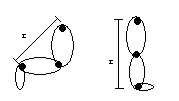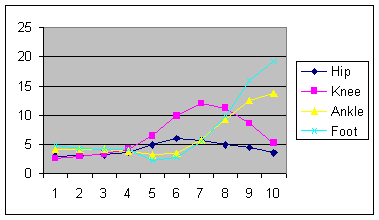 |
 |
 |
 |
 |
 |
 |
 |
 |
 |
 |
 |
 |
 |
The Biomechanics of Taekwondo
By: David P. Cook (B.Sc. Hons)The basic techniques encompassed within the art of Taekwondo (TKD) are those of striking, blocking and kicking. Success in each of these, be it in terms of competition, self-defence or training is dependent on a number of factors, some of which are biomechanical in nature. Biomechanics is concerned with the application of mechanical principles to biological systems.
The most apparent biomechanical factors that are relevant to �success� in TKD are those which relate to the technical performance of specific skills. Biomechanics serves to improve the understanding of the mechanical effectiveness of their execution and to identify the factors underlying their successful performance. This knowledge and understanding can help to enhance the learning and performance of these skills.
Let us take Kicking as our main example:
Although the leg is one of the larger segments of the body it is very important for the TKD practitioner to be able to move this segment as quickly as possible in order to execute a kick that is not easily blocked or recognised. The initial characteristic of the kicking technique is a rapid knee lift of the kicking leg; in biomechanical terms this action serves to reduce the Moment of Inertia (MoI) of the segment by reducing the distance of the segment to the centre of rotation (radius of rotation �r�). What this basically refers to is the segments resistance to rotation, when kicking, rotation is predominantly about the hip and therefore a reduced MoI will result in a much quicker rotation about this joint (See Figure 1).

Figure 1: Reduction of �r� caused by flexion of the leg at the knee.
In addition, this initial movement is to the advantage of the �exponent� in that it provides them with the potential to produce several variations of kick from the same or similar mechanically based movements. A good simile for this is when pitching in baseball, in order to disguise the delivery from the batter the pitcher will employ very similar body and arm movements for each pitch, reducing the time that the batter has to react once the actual pitch has been recognised.
Another principle of biomechanics that is evident in TKD is that of sequential motion, this basically refers to the way in which segments of the body are co-ordinated in order to achieve high speed at the end of a movement. Fast unloaded movements (i.e. striking, throwing and kicking) are typically performed in a proximal to distal fashion (nearest segment to the body, e.g. thigh, to the segment farthest from the body, e.g. foot). The aim of this pattern of movement is to achieve a high velocity at the end of the linkage, in essence enabling a more forceful impact. Figure 2 highlights a proficient sequential action, each joint centre reaching a peak prior to the next in the linkage, slight deceleration is then observed as momentum is transferred from the large, heavy segments to the smaller, lighter more distal segments.

Figure 2: Velocity at joint centres during kicking.
The examples above go some way to highlighting the importance of biomechanics within the martial art of Taekwondo; an understanding of the basic principles enables a greater understanding of performance and may also serve to identify specific components of technique that may increase propensity towards injury.